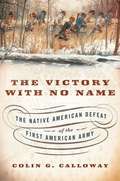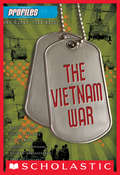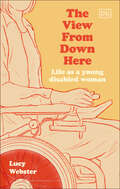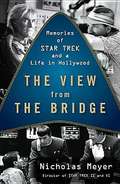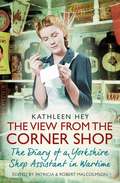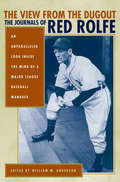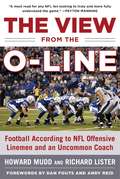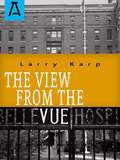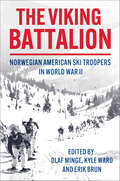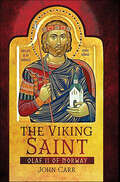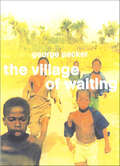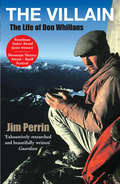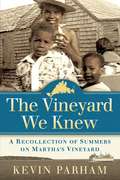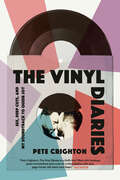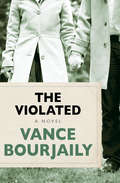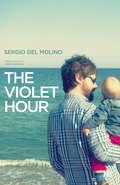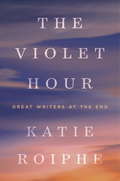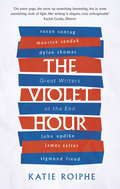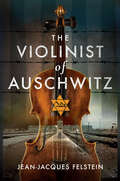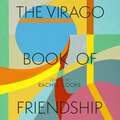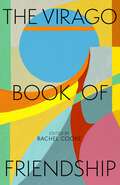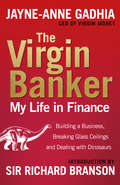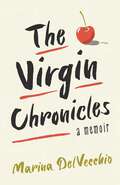- Table View
- List View
The Victory With No Name: The Native American Defeat Of The First American Army
by Colin G. CallowayIn 1791, General Arthur St. Clair led the United States army in a campaign to destroy a complex of Indian villages at the Maumee River in northwestern Ohio. Almost within reach of their objective, St. Clair's 1,400 men were attacked by about one thousand Indians. The U. S. force was decimated, suffering nearly one thousand casualties in killed and wounded, while Indian casualties numbered only a few dozen. But despite the lopsided result, it wouldn't appear to carry much significance; it involved only a few thousand people, lasted less than three hours, and the outcome, which was never in doubt, was permanently reversed a mere three years later. Neither an epic struggle nor a clash that changed the course of history, the battle doesn't even have a name. Yet, as renowned Native American historian Colin Calloway demonstrates here, St. Clair's Defeat--as it came to be known-- was hugely important for its time. It was both the biggest victory the Native Americans ever won, and, proportionately, the biggest military disaster the United States had suffered. With the British in Canada waiting in the wings for the American experiment in republicanism to fail, and some regions of the West gravitating toward alliance with Spain, the defeat threatened the very existence of the infant United States. Generating a deluge of reports, correspondence, opinions, and debates in the press, it produced the first congressional investigation in American history, while ultimately changing not only the manner in which Americans viewed, raised, organized, and paid for their armies, but the very ways in which they fought their wars. Emphasizing the extent to which the battle has been overlooked in history, Calloway illustrates how this moment of great victory by American Indians became an aberration in the national story and a blank spot in the national memory. Calloway shows that St. Clair's army proved no match for the highly motivated and well-led Native American force that shattered not only the American army but the ill-founded assumption that Indians stood no chance against European methods and models of warfare. An engaging and enlightening read for American history enthusiasts and scholars alike, The Victory with No Name brings this significant moment in American history back to light.
The Vietnam War: The Vietnam War (Profiles #5)
by Daniel PolanskyIt takes more than one person to bring about War. This book will follow the lives of six key players during one of the most controversial wars in history.Profiles is so much more than just your typical biography. This book in our six-in-one, full-color bio series will focus on the five W's of the Vietnam War--who, what, where, when, and why. Kids will learn all of the biographical information they need to know (background, family, education, accomplishments, etc.) about: Ho Chi Minh (prime minister of Democratic Republic of Vietnam) John F. Kennedy (US president 1961-1963), Lyndon B. Johnson (US president (1963-1969), Ngo Dinh Diem (president of South Vietnam), Henry Kissinger (US National security advisor), and William Westmoreland (US army general). This book will help illuminate one of the most controversial wars in American history for a new generation of readers.
The View From Down Here: Life as a Young Disabled Woman
by Lucy WebsterA powerful, eye-opening insight into navigating the world as a disabled young woman Women&’s lives are shaped by sexism and expectations. Disabled people&’s lives are shaped by ableism and a complete lack of expectations. But what happens when you&’re subjected to both sets of rules? This powerful, honest, hilarious, and furious memoir from journalist and advocate Lucy Webster looks at life at the intersection: the struggles, the joys, and the unseen realities of being a disabled woman. From navigating the worlds of education and work, dating, and friendship to managing care, contemplating motherhood, and learning to accept your body against a pervasive narrative that it is somehow broken and in need of fixing, The View From Down Here shines a light on what it really means to move through theworld as a disabled woman.
The View From Serendip
by Arthur C. ClarkeThis book includes many articles on the personal universe of Arthur C. Clarke, including life at home on his island paradise, in ancient times called Serendip, then Ceylon, now Sri Lanka, his continuing involmement with space travel from the earliest days as a member of the British interplanetary Society to his coverage of the Apollo moon shots for CBS television, to the world of 2001 ... or what's in store for us in the nest 20 years, and more
The View From the Bridge: Memories of Star Trek and a Life in Hollywood
by Nicholas MeyerThe critically acclaimed director and writer shares his account of the making of the three classic Star Trek filmsThe View from the Bridge is Nicholas Meyer's enormously entertaining account of his involvement with the Star Trek films: STII: The Wrath of Khan, STIV: The Voyage Home, and STVI: The Undiscovered Country, as well as his illustrious career in the movie business. The man best known for bringing together Sherlock Holmes and Sigmund Freud in The Seven Per-Cent Solution had ironically never been interested in Star Trek until he was brought on board to save the film series. Meyer shares how he created the script for The Wrath of Khan, the most revered Star Trek film of all, in twelve days-only to have William Shatner proclaim he hated it. He reveals the death threats he received when word got out that Spock would be killed, and finally answers the long-pondered question of whether Khan's chiseled chest is truly that of Ricardo Montalban. Meyer's reminiscences on everyone from Gene Roddenberry to Laurence Olivier will appeal not only to the countless legions of Trekkies, but to anyone fascinated by the inner workings of Hollywood.
The View From the Corner Shop: The Diary of a Yorkshire Shop Assistant in Wartime
by Kathleen Hey Patricia Malcolmson Robert MalcolmsonKathleen Hey spent the war years helping her sister and brother-in-law run a grocery shop in the Yorkshire town of Dewsbury. From July 1941 to July 1946 she kept a diary for the Mass-Observation project, recording the thoughts and concerns of the people who used the shop. What makes Kathleen's account such a vivid and compelling read is the immediacy of her writing. People were pulling together on the surface ('Bert has painted the V-sign on the shop door...', she writes) but there are plenty of tensions underneath. The shortage of food and the extreme difficulty of obtaining it is a constant thread, which dominates conversation in the town, more so even than the danger of bombardment and the war itself. Sometimes events take a comic turn. A lack of onions provokes outrage among her customers, and Kathleen writes, 'I believe they think we have secret onion orgies at night and use them all up.' The Brooke Bond tea rep complains that tea need not be rationed at all if supply ships were not filled with 'useless goods' such as Corn Flakes, and there is a long-running saga about the non-arrival of Smedley's peas. Among the chorus of voices she brings us, Kathleen herself shines through as a strong and engaging woman who refuses to give in to doubts or misery and who maintains her keen sense of humour even under the most trying conditions.A vibrant addition to our records of the Second World War, the power of her diary lies in its juxtaposition of the everyday and the extraordinary, the homely and the universal, small town life and the wartime upheavals of a nation.
The View from the Dugout: The Journals of Red Rolfe
by William M. Anderson"Somewhere, if they haven't been destroyed, there are hundreds of pages of typewritten notes about American League players of that era, notes which I would love to get my hands on." -Bill James, in The New Bill James Historical Baseball Abstract, on the journals of Red Rolfe. "Red Rolfe's journal for his years as manager of the Detroit Tigers is the kind of precious source researchers yearn for. In combination with William M. Anderson's well-done text, The View from the Dugout will be of great interest to general readers and of immense value to students of baseball history." -Charles C. Alexander, author of Breaking the Slump: Baseball in the Depression Era. "Red Rolfe was one of baseball's most astute observers. This is 'inside' baseball from the inside." -Donald Honig, author of Baseball America, Baseball When the Grass Was Real, and other books in the Donald Honig Best Players of All Time series. "In his lucid journals Red Rolfe has provided an inside look at how an intelligent baseball manager thinks and prepares." -Ray Robinson, Yankee historian and author of Iron Horse: Lou Gehrig in His Time. Baseball players as a rule aren't known for documenting their experiences on the diamond. Red Rolfe, however, during his time as manager of the Detroit Tigers from 1949 to 1952, recorded daily accounts of each game, including candid observations about his team's performance. He used these observations to coach his players and to gain an advantage by recording strengths, weaknesses, and tendencies of opposing players and managers. Rolfe's journals carry added value considering his own career as an All-Star Yankee third baseman on numerous world champion teams, where he was a teammate of Lou Gehrig and Joe DiMaggio. Today, in the era of televised broadcasts, networks often wire a manager so that viewers can listen to his spontaneous comments throughout the game. Red Rolfe's journals offer an opportunity to find out what a manager is thinking when no one is around to hear. William M. Anderson is Director of the Department of History, Arts and Libraries for the State of Michigan. His books include The Detroit Tigers: A Pictorial Celebration of the Greatest Players and Moments in Tigers' History.
The View from the O-Line: Football According to NFL Offensive Linemen and an Uncommon Coach
by Dan Fouts Andy Reid Howard Mudd Richard ListerThe View from the O-Line is an NFL narrative that has yet to be told, about men who game-in and game-out take grueling physical punishment without the expectation of fame and media attention. These are the men who make up the offensive line.Howard Mudd spent more than forty years in the NFL, first as a player and later as a coach. His narrative anchors this work while more than twenty contributors: current and former NFL players-including Nick Mangold, Jeff Saturday, Frank Winters, and Jackie Slater-executives, and officials, add their richly told stories that chronicle the biases faced and overcome by those in this intricate and underestimated position, weaving together an admirable new image of the men playing the sport for reasons beyond simple glory. Clever in craft and modest in spirit, these unheralded players wield the power to make or break a game.Skyhorse Publishing, as well as our Sports Publishing imprint, are proud to publish a broad range of books for readers interested in sports-books about baseball, pro football, college football, pro and college basketball, hockey, or soccer, we have a book about your sport or your team.Whether you are a New York Yankees fan or hail from Red Sox nation; whether you are a die-hard Green Bay Packers or Dallas Cowboys fan; whether you root for the Kentucky Wildcats, Louisville Cardinals, UCLA Bruins, or Kansas Jayhawks; whether you route for the Boston Bruins, Toronto Maple Leafs, Montreal Canadiens, or Los Angeles Kings; we have a book for you. While not every title we publish becomes a New York Times bestseller or a national bestseller, we are committed to publishing books on subjects that are sometimes overlooked by other publishers and to authors whose work might not otherwise find a home.
The View from the Vue
by Larry Karp"We called it THE VUE, and without a doubt, that was the most complimentary nickname Bellevue Hospital ever had. " So begins The View from the Vue, an "entertaining, colorful recall" (Publishers Weekly) of life a half-century ago at New York City's medical court of last resort. Between 1959 and 1965, Dr. Larry Karp served as medical student, intern, and resident physician at Bellevue. During these six years, he came to know and understand the people who wended their way through the dingy hallways and roach-infested subterranean passages, and inhabited the sparsely furnished wards of the fabulous hospital whose origins date back to 1811. It's not surprising that Dr. Karp has never been able to forget The Vue. Writing in a style both human and humorous, he recalls some of the astonishingly funny and dramatic events he lived through, involving bizarre patients and grotesque working conditions. In the process, he gives us a clear picture of what it was like at Bellevue in the early sixties . . . for both doctors and patients.
The Viking Battalion: Norwegian American Ski Troopers in World War II
by Kyle Ward Olaf Minge"What is engaging about this book is that you get to hear the authentic voices of the soldiers through their memoirs, journal entries, and letters. Some are long, some are short, but all are worth reading for the insights you get into the minds of the ordinary soldier and what catches his eye." — The Norwegian American Hidden in the crevasses of World War II history is the story of the 99th Infantry Battalion (Separate). A small unit that rarely gets any attention, it is part of a fascinating story. Alongside battalions of Austrian, Greek, Filipino and Japanese Americans, the Army decided to create an all Norwegian American battalion, originally trained at Camp Hale, Colorado, along with the 10th Mountain Division, with the original mission of liberating Norway. Their exploits during training brought them enough notoriety that members of the 99th were recruited to start the First Special Service Force and a branch of the OSS. Although they were not initially sent to Norway, they would fight in Normandy, across France and Belgium, helped entrap the Germans at Aachen, protected the city of Malmedy during the Battle of the Bulge (where they stopped an attack by Skorzeny and a SS Panzer Division), helped liberate Buchenwald, guarded the Nazi treasures found in Merkers mine and finally served as the Honor Guard for King Haakon VII on his triumphant return to Norway. This book tells the story of the 99th Infantry Battalion through an anthology of rarely, if ever, previously seen memoirs, journals, letters and newspaper articles written by or about the Viking soldiers.
The Viking Saint: Olaf II of Norway
by John CarrThe Vikings and sainthood are not concepts normally found side by side. But Norway’s King Olaf II Haraldsson (c. 995-1030) embodied both to an extraordinary degree. As a battle-eager teenager he almost single-handedly pulled down London Bridge (as in the nursery rhyme) and took part in many other Viking raids . Olaf lacked none of the traditional Viking qualities of toughness and audacity, yet his routine baptism grew into a burning missionary faith that was all the more remarkable for being combined with his typically Viking determination and energy – and sometimes ruthlessness as well. His overriding mission was to Christianize Norway and extirpate heathenism. His unstinting efforts, often at great peril to his life, earned him the Norwegian throne in 1015, when he had barely reached his twenties. For the next fifteen years he laboured against immense odds to subdue the rebellious heathen nobles of Norway while fending off Swedish hostility. Both finally combined against Olaf in 1030, when he fell bravely in battle not far from Trondheim, still only in his mid-thirties. After his body was found to possess healing powers, and reports of them spread from Scandinavia to Spain and Byzantium, Olaf II was canonized a saint 134 years later. He remains Norway’s patron saint as well as a legendary warrior. Yet more remarkably, he remains a saint not only of the Protestant church but also of the Roman Catholic and Greek Orthodox Churches – perhaps the only European fighting saint to achieve such acceptance.
The Village of Waiting
by George PackerNow restored to print with a new Foreword by Philip Gourevitch and an Afterword by the author, The Village of Waiting is a frank, moving, and vivid account of contemporary life in West Africa. Stationed as a Peace Corps instructor in the village of Lavié (the name means "wait a little more") in tiny and underdeveloped Togo, George Packer reveals his own schooling at the hands of an unforgettable array of townspeople--peasants, chiefs, charlatans, children, market women, cripples, crazies, and those who, having lost or given up much of their traditional identity and fastened their hopes on "development," find themselves trapped between the familiar repetitions of rural life and the chafing monotony of waiting for change.
The Villain: The Life of Don Whillans
by Jim PerrinDon Whillans has an iconic significance for generations of climbers. His epoch-making first ascent of Annapurna's South Face, achieved with Dougal Haston in 1970, remains one of the most impressive climbs ever made - but behind this and all his other formidable achievements lies a tough, recalcitrant reality: the character of the man himself.Whillans carried within himself a sense of personal invincibility, forceful, direct and uncompromising. It gave him sporting superstar status - the flawed heroism of a Best, a McEnroe, an Ali. In his own circle, his image was the working-class hero on the rock-face, laconic and bellicose, ready to go to war with the elements or with any human who crossed his path on a bad day.
The Vineyard We Knew: A Recollection of Summers on Martha's Vineyard
by George Foster Kevin Parham Kathy Grow Dorie McClellanThe Vineyard We Knew is a candid, un-sanitized story about spending summers on Martha's Vineyard under humble circumstances. It's a coming-of-age memoir that unfolds from the perspective of a child, an adolescent, and a teenager. It then interjects the wisdom one acquires as an adult, and takes a look back at our childhood experiences, making note of the juxtaposition between things that are viewed from the vantage point of maturity as opposed to that which is seen through the eyes of an innocent child. <P><P> This book embraces the fact that no matter who we are, where we come from, or what our social or economic circumstances might be, our childhood experiences are a blueprint for the rest of our lives.
The Vinyl Diaries: Sex, Deep Cuts, and My Soundtrack to Queer Joy
by Pete CrightonA poignant, funny, and lively memoir of sexual awakening, music, and discovering one's true self. Pete Crighton came of age in the early/mid 1980s in the shadow of HIV/AIDS. Growing up in Toronto, he was terrified that his friends and schoolmates would find out that he was &“different&” at a time when being gay felt like a death sentence. His only comfort was music, the songs a balm to his painful adolescence. Struggling to make sense of his sexuality and fear of the disease stifled Crighton as a sexual being. Instead of exploring sex, he began curating a massive music library. He then took what he thought was a safe path and entered into two long-term monogamous relationships, both doomed to fail. Finally, in his 40s, Crighton decided to ignore his fear and live his queer life to the fullest.The Vinyl Diaries is the story of Crighton&’s mid-life sexual awakening. From one-night trysts to friendships resulting from app-based hookups, Crighton is honest and unapologetic as he chronicles the pursuit of his erotic desires. Each new connection and lover is linked to an artist, song, or album from his vast collection and backdrops the stories Crighton tells about his life, interconnected with the artists' work and histories. Kate Bush, the B-52s, Prince, The Smiths, Yoko Ono, and Stevie Nicks are just a few of the artists who provide an extraordinary soundtrack to Crighton&’s adventures.Big-hearted, funny, thoughtful, and wildly entertaining, The Vinyl Diaries is a celebration of sex, music and the discovery of our true selves.
The Violated: A Novel
by Vance Bourjaily"One of the very few good, ambitious and important novels to have been done by the writers of my generation." --Norman Mailer The lives of four Americans born between the world wars are intertwined to devastating effect in this gripping novel from one of the twentieth century's most acclaimed authors. Beautiful, sad Ellen Beniger; her younger brother, Tom, a scholar unhappily moonlighting as a TV writer; the athletic amorist Guy Cinturon; and tough little Eddie Bissle, ex-infantryman and Ellen's secret lover, struggle to come to grips with the limits of their futures and the scars of their pasts as they enter middle age. Will the physical, emotional, and spiritual violations they have endured remain with them forever, or can they be healed? As The Violated builds to its stunning climax, the story of four lost souls reveals heartbreaking truths about the dark side of post-World War II America.
The Violet Hour
by James Womack Sergio Del MolinoWinner of the Premio Ojo Crítico and Premio Tigre Juan, The Violet Hour is the celebration of a life cut short. A deeply moving memoir that shows us the inner life of a man confronted with his own limitations.Children who lose their parents are orphans, and those who have to close their spouse's dead eyes are widows and widowers. But we, the parents who sign the documents authorizing our children's funerals, we have no name, no civil status. We remain parents forever.Sergio del Molino is a Spanish writer and journalist who lives in Zaragoza. He has worked for almost ten years as a reporter in the Heraldo de Aragón, where he writes a Sunday column.
The Violet Hour
by Katie RoipheFrom one of our most perceptive and provocative voices comes a deeply researched account of the last days of Susan Sontag, Sigmund Freud, John Updike, Dylan Thomas, and Maurice Sendak--an arresting and wholly original meditation on mortality. In The Violet Hour, Katie Roiphe takes an unexpected and liberating approach to the most unavoidable of subjects. She investigates the last days of five great thinkers, writers, and artists as they come to terms with the reality of approaching death, or what T. S. Eliot called "the evening hour that strives Homeward, and brings the sailor home from sea." Roiphe draws on her own extraordinary research and access to the family, friends, and caretakers of her subjects. Here is Susan Sontag, the consummate public intellectual, who finds her commitment to rational thinking tested during her third bout with cancer. Roiphe takes us to the hospital room where, after receiving the worst possible diagnosis, seventy-six-year-old John Updike begins writing a poem. She vividly re-creates the fortnight of almost suicidal excess that culminated in Dylan Thomas's fatal collapse on the floor of a Greenwich Village tavern. She gives us a bracing portrait of Sigmund Freud fleeing Nazi-occupied Vienna only to continue in his London exile the compulsive cigar smoking that he knows will hasten his decline. And she shows us how Maurice Sendak's beloved books for children are infused with his lifelong obsession with death, if you know where to look. The Violet Hour is a book filled with intimate and surprising revelations. In the final acts of each of these creative geniuses are examples of courage, passion, self-delusion, pointless suffering, and superb devotion. There are also moments of sublime insight and understanding where the mind creates its own comfort. As the author writes, "If it's nearly impossible to capture the approach of death in words, who would have the most hope of doing it?" By bringing these great writers' final days to urgent, unsentimental life, Katie Roiphe helps us to look boldly in the face of death and be less afraid.From the Hardcover edition.
The Violet Hour: Great Writers at the End
by Katie RoipheThe last days of five great thinkers, writers and artists - as they come to terms with the reality of approaching deathKatie Roiphe's extraordinary book is filled with intimate and surprising revelations. Susan Sontag, consummate public intellectual, finds her rational thinking tested during her third bout with cancer. Seventy-six year old John Updike's response to a fatal diagnosis is to begin a poem. Dylan Thomas's fatal collapse on the floor of a Greenwich Village tavern is preceded by a fortnight of almost suicidal excess. Sigmund Freud understands his hastening decline. Maurice Sendak shows his lifelong obsession with death in his beloved books.The Violet Hour - urgent and unsentimental - helps us to be less afraid in the face of death.
The Violinist of Auschwitz
by Jean-Jacques FelsteinA son chronicles his Jewish mother&’s real-life efforts to save as many young women as possible from the Auschwitz gas chambers during World War II. Arrested in 1943 and deported to Auschwitz, Elsa survived because she had the &“opportunity&” to join the women&’s orchestra. But Elsa kept her story a secret, even from her own family. Indeed, her son would only discover what had happened to his mother many years later, after gradually unearthing her unbelievable story following her premature death, without ever having revealed her secret to anyone . . . Jean-Jacques Felstein was determined to reconstruct Elsa&’s life in Birkenau, and would go in search of other orchestra survivors in Germany, Belgium, Poland, Israel, and the United States. The recollections of Hélène, first violin, Violette, third violin, Anita, a cellist, and other musicians, allowed him to rediscover his twenty-year-old mother, lost in the heart of hell. The story unfolds in two intersecting stages: one, contemporary, is that of the investigation, the other is that of Auschwitz and its unimaginable daily life, as told by the musicians. They describe the recitals on which their very survival depended, the incessant rehearsals, the departure in the mornings for the forced labourers to the rhythm of the instruments, the Sunday concerts, and how Mengele pointed out the pieces in the repertoire he wished to listen to in between &“selections.&” In this remarkable book, Jean-Jacques Felstein follows in his mother&’s footsteps and by telling her story, attempts to free her, and himself, from the pain that had been hidden in their family for so long.
The Virago Book of Friendship
by Rachel CookeA fond, fascinated look at women's friendship through the fiction, diaries, and letters of friends Friendship, a timeless subject, has never been more debated, something that has to do both with the internet - the perils of WhatsApp groups, the agony of ghosting - as well as with a growing awareness that loneliness is increasing in our society. Friendship has become a matter of urgent inquiry to therapists, scientists and sociologists. We understand its importance more and more, not only as a comfort and a privilege, but as vital to our health. But it's hard to get inside friendship: its particular intensity and its miraculous ease; its tendency to wax and wane; its ability to inspire both delight and despair. This is the territory of novels and poems, diaries and letters, comics and graphic novels - and it is where the innovative and wide ranging Virago Book of Friendship steps in, bringing together work by more than 100 writers. From Jane Austen to Edith Wharton and Virginia Woolf, from Dolly Alderton to Sarah Waters and Meg Wolitzer and, it celebrates and investigates friendship between women from first encounters to final goodbyes, from falling out to making up again.
The Virago Book of Friendship
by Rachel CookeA fond, fascinated look at women's friendship through the fiction, diaries, and letters of friends Friendship, a timeless subject, has never been more debated, something that has to do both with the internet - the perils of WhatsApp groups, the agony of ghosting - as well as with a growing awareness that loneliness is increasing in our society. Friendship has become a matter of urgent inquiry to therapists, scientists and sociologists. We understand its importance more and more, not only as a comfort and a privilege, but as vital to our health. But it's hard to get inside friendship: its particular intensity and its miraculous ease; its tendency to wax and wane; its ability to inspire both delight and despair. This is the territory of novels and poems, diaries and letters, comics and graphic novels - and it is where the innovative and wide ranging Virago Book of Friendship steps in, bringing together work by more than 100 writers. From Jane Austen to Edith Wharton and Virginia Woolf, from Dolly Alderton to Sarah Waters and Meg Wolitzer and, it celebrates and investigates friendship between women from first encounters to final goodbyes, from falling out to making up again.
The Virgin Banker
by Jayne-Anne GadhiaJayne-Anne Gadhia, the straight-talking CEO of Virgin Money, looks back at the events that have influenced, shaped and inspired her to become one of the most powerful women in banking.With anecdotes from her life before becoming a banker, including beating the bullies and experiencing racism as part of a mixed race marriage, through to building a business from scratch, working at RBS under Fred Goodwin just before the financial crash, and steering Virgin Money to become a listed business, breaking boundaries along the way, professionally and personally.Jayne-Anne shines a light on issues surrounding the role of women in banking and the alpha-male dinosaurs that dominate the industry. She draws on the relationships and deals that have shaped her career so far, including her personal experience with mental health issues, which has helped her attitude and approach to both her business and personal life. This is not a conventional biography, nor a ‘how to do it’ business book. It is a candid, fresh and fascinating insight into being a woman in business, the financial crisis and the way in which business can be conducted as a force for good.
The Virgin Chronicles: A Memoir
by Marina DelVecchioKathy is a virgin in her twenties trying to navigate the blurred lines between sex and love even as outside forces attempt to detach her from her sexual autonomy. At home, her adoptive mother&’s eyes investigate her body for evidence of sexual promiscuity and, despite her protests, she is called a putana—a whore—for her perceived sexual debauchery. At work, meanwhile, she is sexually harassed by male managers who slap her butt, tell her they want Greek for lunch (wink, wink), and fill out recommendation forms about her sexy qualities. A young girl on the cusp of womanhood, she encounters a version of herself as men experience her: hypersexualized and objectified. As if this is not enough, Kathy enters the dating scene in search of love only to find herself fending off young men who want her just for sex. In each relationship, Kathy uncovers her own strength and conviction as she fights for the kind of sex she wants instead of the kind of empty sex boys seem to require of girls. The more demands they make, the more determined she is to hold out for love—even if it means losing a guy or going home single and alone. Raw and empowering, The Virgin Chronicles sends the message that love is worth waiting for and sex is better when it&’s paired with self-actualization.
The Virgin Queen: Elizabeth I, Genius of the Golden Age
by Christopher HibbertBiography of the woman who was queen for 45 years, during England's most dazzling era.
